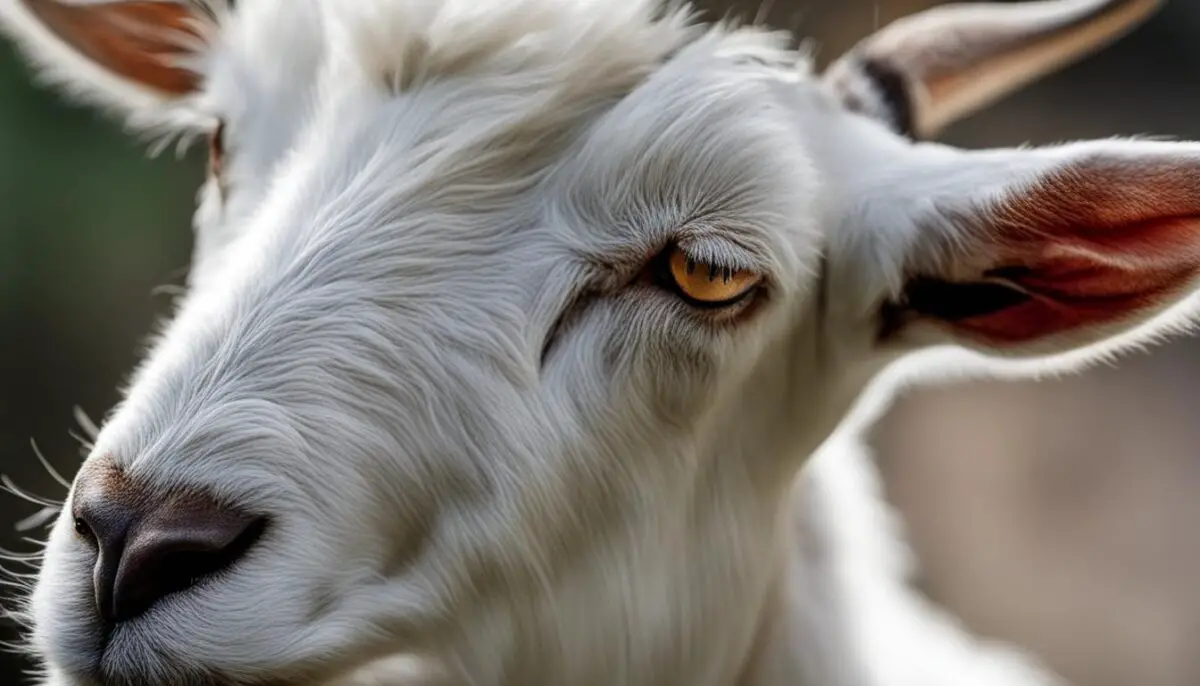Goat foaming at the mouth, also known as frothy bloat, can be a cause for concern among goat owners. It is important to understand the causes and find appropriate solutions to ensure the well-being of these animals.
There are various factors that can lead to a goat foaming at the mouth. Overeating of lush and damp feed such as clover, alfalfa, or legume pasture is a common cause. This can result in the expansion of the rumen with foam, leading to respiratory or circulatory failure. Other causes may include poisoning, excessive salivation, uneven teeth, or even symptoms of rabies.
Identifying the underlying cause is crucial in addressing this issue effectively. By taking appropriate measures and providing the necessary care, goat owners can help prevent and manage foaming at the mouth in their animals.
Key Takeaways:
- Goat foaming at the mouth, also known as frothy bloat, can be caused by overeating lush and damp feed or other factors such as poisoning or symptoms of rabies.
- Understanding the underlying cause is crucial to finding appropriate solutions and ensuring the well-being of goats.
- Preventative measures such as managing the goat’s diet and providing proper dental care can help avoid foaming at the mouth.
- Regular veterinary care and access to animal health resources are important in maintaining goat health.
- Addressing complications and seeking timely treatment is crucial to prevent further health issues.
Common Reasons for Goat Foaming at the Mouth
Goat foaming at the mouth, also known as frothy bloat, is primarily caused by bloat in goats. Bloat is an over-distention of the rumen with gases of fermentation, resulting in the formation of persistent foam mixed with ruminal contents. Leguminous bloat is the most common type of bloat in goats, especially when they graze on bloat-prone pastures dominated by leguminous plants like alfalfa and clover.
The foam formed during bloat can be classified into three types: acute foam, intermediate foam, and delayed foam. Acute foam is the most common type in goats and is characterized by the rapid formation of stable foam. This foam leads to the accumulation of gases in the rumen, causing discomfort and respiratory difficulties for the goat.
To prevent bloat in goats, it is essential to manage their diet carefully. Avoiding bloat-prone pastures and providing alternative forages can help. Additionally, ensuring proper dental care and regular monitoring of the goat’s health can help in early detection and prevention of goat foaming at the mouth.
Table: Types of Bloat in Goats
| Type of Bloat | Description |
|---|---|
| Acute Foam | Rapid formation of stable foam, leading to accumulation of gases in the rumen |
| Intermediate Foam | Slower formation of stable foam, often occurring after consuming large amounts of rich feed |
| Delayed Foam | Foam formed hours after consuming bloat-inducing feed, typically associated with leguminous plants |
“Goat foaming at the mouth can be a distressing condition caused by bloat, specifically frothy bloat. It is important for goat owners to be aware of the common reasons for goat foaming at the mouth, especially leguminous bloat, and take preventative measures to ensure the health of their animals.”
Symptoms of Goat Foaming at the Mouth
When a goat starts foaming at the mouth, it is important to identify the symptoms and take appropriate action. One of the most noticeable symptoms is excessive drooling, where the goat will have an unusually large amount of saliva coming out of its mouth. This drooling may be accompanied by frothy saliva, giving the appearance of foam around the mouth. These visual cues are clear indicators that the goat is experiencing foaming at the mouth.
Aside from the visible foaming, other symptoms may manifest in the goat’s behavior and physical appearance. The goat may exhibit grinding teeth, indicating discomfort or pain. Drooping ears and signs of distress such as restlessness or agitation may also be present. In severe cases, the goat might struggle to breathe properly, with symptoms including difficulty in breathing, protrusion of the tongue, and increased urination.
Recognizing these symptoms early on allows goat owners to take immediate action and address the underlying cause of the foaming. By monitoring the goat’s behavior and regularly checking for signs of excessive drooling or frothing at the mouth, owners can ensure the goat’s well-being and prevent further complications.

Summary:
- Excessive drooling and frothy saliva are common symptoms of goat foaming at the mouth.
- Other symptoms may include grinding teeth, drooping ears, and signs of distress.
- In severe cases, goats may experience difficulty breathing and frequent urination.
- Early recognition of these symptoms allows for prompt action and addressing the underlying cause of the foaming.
Etiology of Goat Foaming at the Mouth
The etiology of goat foaming at the mouth is a complex process that involves the formation of stable foam in the rumen. This foam is created when gases of fermentation become entrapped in a stable foam matrix. Both animals and plants contribute to the formation of stable foam, with certain plants containing foaming agents that make the foam more stable at specific pH levels. Legume forages, such as alfalfa and clover, are particularly associated with foamy bloat in goats.
The formation of stable foam in the rumen occurs when the gases produced during fermentation combine with the ruminal contents and create a persistent foam. This foam then puts pressure on the diaphragm, leading to respiratory or circulatory failure. It is important to note that the presence of excessive foam can also impede the release of gas from the rumen, exacerbating the problem.
“The etiology of goat foaming at the mouth involves a delicate balance between the ruminal microorganisms, fermentation processes, and the composition of the feed.”
Various factors can influence the etiology of goat foaming at the mouth. These factors include the type and quality of forages consumed by the goat, the pH level of the rumen, and the presence of certain microorganisms. By understanding the complex etiology of goat foaming at the mouth, goat owners can take appropriate measures to prevent and manage this condition effectively.
Foam Formation Process in the Rumen
The process of foam formation in the rumen involves the interaction of gases, microorganisms, and feed particles. When certain conditions are met, stable foam can develop, leading to goat foaming at the mouth. The table below provides a summary of the foam formation process in the rumen:
| Stage | Description |
|---|---|
| 1 | Release of gases during fermentation |
| 2 | Entrapment of gases in the rumen contents |
| 3 | Aggregation of feed particles, microbes, and gases |
| 4 | Formation of stable foam matrix |
| 5 | Pressure on diaphragm, leading to respiratory or circulatory failure |
Treatment and Prevention of Goat Foaming at the Mouth
Proper treatment and prevention strategies are crucial in addressing goat foaming at the mouth and ensuring the health and well-being of your goats. The specific treatment for goat foaming at the mouth depends on the underlying cause, but there are general measures that can be taken to prevent this condition from occurring.
Treatment:
- If your goat is experiencing bloat, emergency solutions such as rumenotomy or the use of antifoaming agents may be necessary to relieve the pressure and remove the foam from the rumen.
- It is important to consult with a veterinarian for professional guidance and to determine the most appropriate treatment options for your goat based on the specific cause of foaming at the mouth.
Prevention:
- Proper management of your goat’s diet is essential in preventing foaming at the mouth. Avoid feeding them excessive amounts of lush, damp feed such as clover, alfalfa, or legume pasture, as these can contribute to bloat.
- Regular dental care is important to ensure that your goat’s teeth are properly aligned and that they can effectively chew their food, reducing the risk of bloat.
- Avoid grazing your goats on bloat-prone pastures, particularly those dominated by leguminous plants such as alfalfa and clover. Instead, opt for grazing on safe pastures with a balanced forage mix.
- Monitor your goats’ behavior and health regularly, looking out for early signs of foaming at the mouth. Promptly address any concerns or symptoms to prevent further complications.
By implementing these preventive measures and seeking appropriate treatment when necessary, you can minimize the risk of goat foaming at the mouth and ensure the overall health and well-being of your goats.
Table: Common Treatment and Prevention Strategies for Goat Foaming at the Mouth
| Treatment | Prevention |
|---|---|
| Emergency solutions like rumenotomy or antifoaming agents | Proper management of goat’s diet |
| Consultation with a veterinarian for professional guidance | Regular dental care |
| Addressing underlying causes specific to the goat | Avoid grazing on bloat-prone pastures |
| Regular monitoring of behavior and health |
Types of Poisoning Causing Goat Foaming at the Mouth
One potential cause of goat foaming at the mouth is organophosphate poisoning. This type of poisoning can result in three different syndromes: acute foam, intermediate foam, and delayed foam. Acute foam is characterized by the inhibition of an enzyme called acetylcholinesterase, which leads to increased activation of various receptors in the nervous system. This can result in symptoms such as vomiting, diarrhea, salivation, muscle tremors, and seizures.
“Acute foam, one of the syndromes caused by organophosphate poisoning, can result in symptoms such as vomiting, diarrhea, salivation, muscle tremors, and seizures.”
It is important to be aware of the different types of poisoning and their associated symptoms in order to provide appropriate treatment. If you suspect organophosphate poisoning in a goat, it is crucial to seek veterinary assistance immediately. Prompt diagnosis and treatment can significantly improve the chances of recovery for the affected goat.
| Poisoning Type | Symptoms |
|---|---|
| Acute Foam | Vomiting, diarrhea, salivation, muscle tremors, seizures |
| Intermediate Foam | Lethargy, weakness, difficulty breathing, increased heart rate |
| Delayed Foam | Delayed onset of symptoms, weakness, weight loss |
Preventing poisoning in goats involves proper management and supervision. It is important to keep potentially toxic substances, such as pesticides and rodenticides, out of reach of goats. Additionally, ensuring that goats have access to clean and safe grazing areas can help prevent accidental ingestion of harmful plants or chemicals. Regular monitoring and observation of goat behavior can also help detect any signs of poisoning early on, allowing for prompt intervention and treatment.
Choke and Free Gas Bloat in Goats
Choke and free gas bloat are two common conditions that can cause goats to foam at the mouth. Choke occurs when there is an obstruction in the throat or esophagus, preventing gas from escaping the rumen. This can be caused by chunks of food getting stuck or other obstructions blocking the passage. Symptoms of choke in goats include gagging, excessive salivation, and difficulty swallowing. If left untreated, it can lead to severe discomfort, respiratory distress, and even death.
Free gas bloat, on the other hand, occurs when the goat is unable to belch out the gas produced during fermentation. This can happen due to various reasons, such as a physical blockage or a dysfunction in the goat’s digestive system. Symptoms of free gas bloat in goats include distended abdomen, difficulty breathing, and restlessness. If not promptly addressed, free gas bloat can lead to serious complications, such as dehydration, acidosis, and even death.
Both choke and free gas bloat require immediate attention and treatment. For choke, the obstruction needs to be removed by a veterinarian using techniques like tubing or gentle manipulation. In cases of free gas bloat, relieving the gas buildup can be done by inserting a stomach tube or using medications to break down the foam. It is important to monitor goats closely for any signs of choking or free gas bloat and seek veterinary assistance as soon as possible to prevent further complications.

Table: Comparison of Choke and Free Gas Bloat in Goats
| Choke | Free Gas Bloat | |
|---|---|---|
| Cause | Obstruction in throat or esophagus | Inability to belch out gas |
| Symptoms | Gagging, excessive salivation, difficulty swallowing | Distended abdomen, difficulty breathing, restlessness |
| Treatment | Obstruction removal by a veterinarian | Relieving gas buildup through stomach tube or medications |
| Complications | Respiratory distress, death | Dehydration, acidosis, death |
Complications of Goat Foaming at Mouth: Acidosis and other challenges
Goat foaming at the mouth can lead to various complications, with acidosis being a common concern. Acidosis is an imbalance in the rumen caused by the rapid consumption of large quantities of grain. This leads to an overproduction of lactic acid, which can have detrimental effects on the goat’s health. It is important to address acidosis promptly to prevent further complications and ensure the well-being of the animal.
In addition to acidosis, other complications can arise from goat foaming at the mouth. One such complication is polioencephalomalacia, a neurological disorder that can result from thiamine deficiency. Symptoms may include head pressing, aimless wandering, blindness, and seizures. Enterotoxemia, also known as overeating disease, is another potential complication of goat foaming at the mouth. It is caused by the overgrowth of certain bacteria in the intestines and can lead to severe digestive disturbances.
Managing these complications requires prompt veterinary attention. In cases of acidosis, draining or replacing rumen contents may be necessary to restore balance. Thiamine supplementation and supportive care are typically recommended for polioencephalomalacia. Enterotoxemia can be prevented through vaccination and proper management practices, such as avoiding sudden changes in diet and providing adequate fiber for rumen health.
Ensuring the health and well-being of goats involves not only addressing the underlying causes of foaming at the mouth but also being vigilant for potential complications. Regular veterinary care, appropriate nutrition, and proactive management practices are vital for preventing and managing these complications, allowing goats to thrive and lead healthy lives.
Complications of Goat Foaming at Mouth:
| Complication | Description |
|---|---|
| Acidosis | An imbalance in the rumen caused by the rapid consumption of large quantities of grain, resulting in the overproduction of lactic acid. |
| Polioencephalomalacia | A neurological disorder that can occur due to thiamine deficiency, leading to symptoms such as head pressing, aimless wandering, blindness, and seizures. |
| Enterotoxemia | An overgrowth of certain bacteria in the intestines, resulting in severe digestive disturbances. It can be prevented through vaccination and proper management practices. |

Conclusion
In conclusion, goat foaming at the mouth is a serious health issue that requires immediate attention and appropriate treatment. Understanding the causes, symptoms, and treatment options for this condition is crucial for goat owners to ensure the health and well-being of their animals.
Regular veterinary care is essential in maintaining goat health and preventing conditions like foaming at the mouth. It is important for goat owners to establish a relationship with a trusted veterinarian who can provide guidance and treatment when necessary. Additionally, proper nutrition plays a significant role in preventing goat health issues. Ensuring that goats have a well-balanced diet and avoiding bloat-prone pastures can help minimize the risk of foaming at the mouth.
Having access to reliable animal health resources is also invaluable for goat owners. These resources can provide valuable information on goat care, health management, and preventive measures. Staying informed and continuously educating oneself about goat health issues can make a significant difference in the overall well-being of the animals.
In conclusion, by prioritizing goat veterinary care, implementing preventive measures, and utilizing animal health resources, goat owners can effectively address and prevent goat foaming at the mouth, safeguarding the health and happiness of their beloved animals.
FAQ
What causes goat foaming at the mouth?
Goat foaming at the mouth can be caused by bloat, poisoning, excessive salivation, uneven teeth, or symptoms of rabies.
How is bloat related to goat foaming at the mouth?
Bloat, specifically frothy bloat, is the main cause of goat foaming at the mouth. It occurs when the rumen is over-distended with gases of fermentation, resulting in a persistent foam mixed with ruminal contents.
What are the symptoms of goat foaming at the mouth?
Symptoms of goat foaming at the mouth include excessive drooling, frothy saliva, visibly foaming mouth, grinding teeth, drooping ears, signs of discomfort or distress, difficulty breathing, protrusion of the tongue, and frequent urination.
What is the etiology of goat foaming at the mouth?
The etiology of goat foaming at the mouth involves the formation of stable foam in the rumen, caused by the entrapment of fermentation gases in a stable foam matrix. Leguminous forages, such as alfalfa and clover, are commonly associated with foamy bloat in goats.
How is goat foaming at the mouth treated and prevented?
Treatment for goat foaming at the mouth depends on the underlying cause. Bloat may require emergency solutions like rumenotomy or antifoaming agents. Preventative measures include carefully managing the goat’s diet, avoiding bloat-prone pastures, and providing proper dental care. Regular monitoring of the goat’s behavior and health is important.
What types of poisoning can cause goat foaming at the mouth?
Organophosphate poisoning can result in three different syndromes of foam: acute foam, intermediate foam, and delayed foam. Acute foam is characterized by the inhibition of acetylcholinesterase enzyme, leading to symptoms like vomiting, diarrhea, salivation, muscle tremors, and seizures.
What are choke and free gas bloat in goats?
Choke occurs when there is an obstruction in the throat or esophagus, preventing gas from escaping the rumen. Free gas bloat happens when goats can’t belch out gas produced during fermentation. Both conditions require prompt attention and treatment.
What complications can arise from goat foaming at the mouth?
Indigestion, acidosis, and other complications can arise as a result of goat foaming at the mouth. Acidosis occurs when goats consume large quantities of grain too quickly, leading to an imbalance in the rumen and excessive lactic acid production. Other complications such as polioencephalomalacia and enterotoxemia can also occur.
What should goat owners do to ensure the health and well-being of their goats?
Understanding the causes, symptoms, and treatment options for goat foaming at the mouth is important. Regular veterinary care, proper nutrition, and preventative measures can help prevent goat foaming at the mouth and other health issues. Access to animal health resources is also beneficial for staying informed and seeking guidance when needed.


